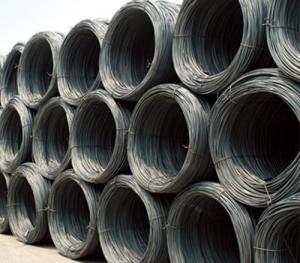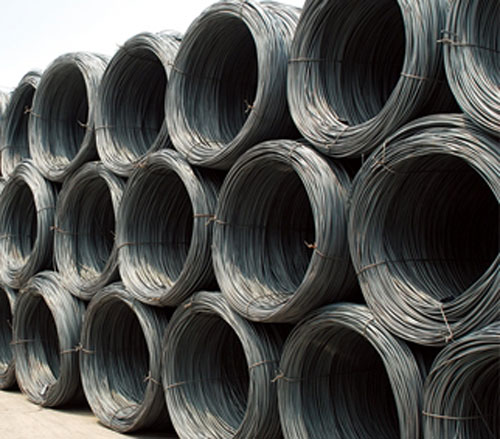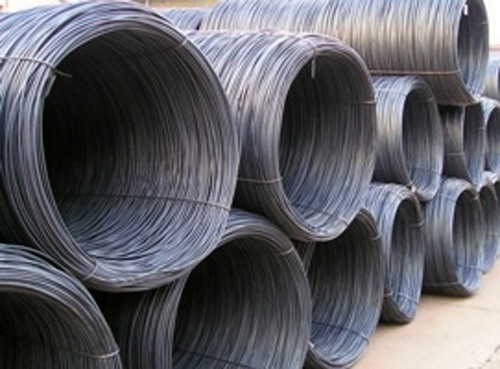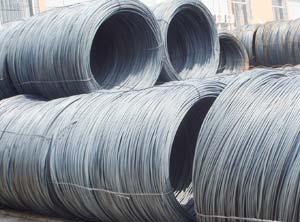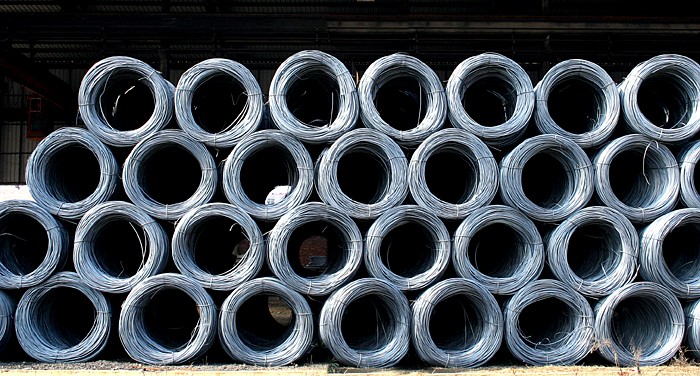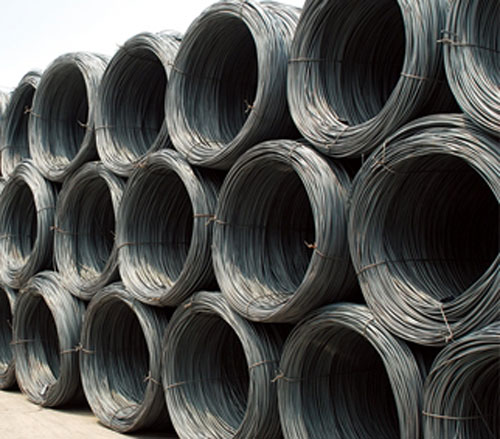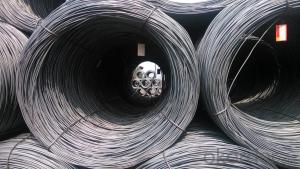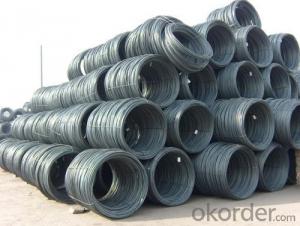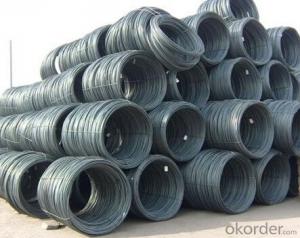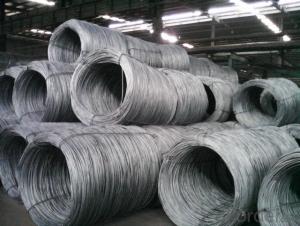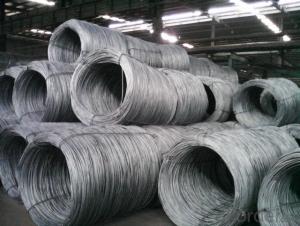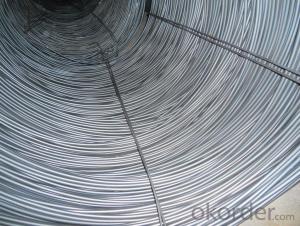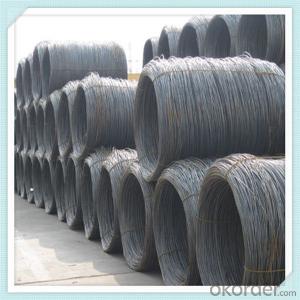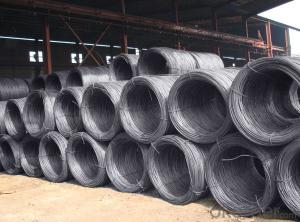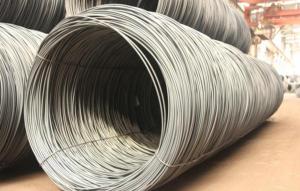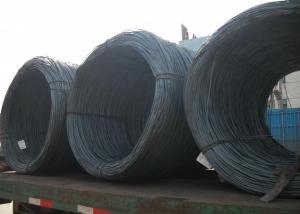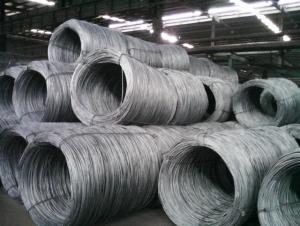Wire Rod SAE1012
- Loading Port:
- China Main Port
- Payment Terms:
- TT OR LC
- Min Order Qty:
- -
- Supply Capability:
- -
OKorder Service Pledge
OKorder Financial Service
You Might Also Like
Product Description:
Specifications of Hot Rolled Wire Rod:
Steel Grade: Q195/235, SAE1006-1018B Standard: ASTM, GB
Diameter: 5.5mm, 6.5mm, 7mm,8mm,9mm,10mm,12mm,14mm
Type: in coil, coil weight around 2MT Alloy or Not: Alloy
Technique: Hot Rolled Place of Origin: China Mainland
Surface: round, no twisted, light and smooth Brand Name: HSKY
Chemical Composition: (Please kindly find our chemistry of our material based on Q195、Q235A and Q235B as below for your information)
| Trademark | Rank | Chemical composition (quality score) % | ||||
| C | Si | Mn | S | P | ||
| ≤ | ≤ | ≤ | ||||
| Q195 | 0.06-0.12 | 0.30 | 0.25 | 0.050 | 0.045 | |
| Q235 | A | 0.14-0.22 | 0.30 | 0.30-0.65 | 0.050 | 0.045 |
| Q235 | B | 0.12-0.20 | 0.30 | 0.30-0.70 | 0.045 | 0.045 |
Usage and Applications of Hot Rolled Wire Rod:
After hot-rolled the products shaped into coil and delivery as finished product, including round, square, rectangular, hexagonal and so on. Since most of the products are round, it is generally called wire rod. Carbon steel wire rod is widely used in construction and manufacturing. Carbon steel wire rod is mainly used for reinforcement of reinforced concrete and welded structure or reprocessed (roberts , nail, etc.) materials, especially used to produce wire drawing, welding electrode, nails, spring, electronic, precise machinery parts and so on.
Packaging & Delivery of Hot Rolled Wire Rod:
Packaging Detail: products are packed in coil, each coil weight around 2 MT, and then shipped by container or bulk vessel
Delivery Detail: within 45 days after received deposit or LC.
Label: to be specified by customer, generally, each bundle has 1-2 labels
Trade terms: FOB, CFR, CIF
- Q: How are steel wire rods used in the manufacturing of surgical instruments?
- Due to their strength, durability, and flexibility, steel wire rods are crucial in the production of surgical instruments. These rods are typically made from high-quality stainless steel, which possesses excellent resistance to corrosion and biocompatibility, making it an ideal material for medical applications. In the manufacturing process of surgical instruments, steel wire rods are initially chosen based on specific requirements such as diameter, tensile strength, and composition. Subsequently, the rods undergo a series of procedures, including cutting, shaping, and bending, in order to form the desired structure of the instrument. One common application of steel wire rods in surgical instruments is for the creation of the shaft or handle. These rods are often shaped into intricate patterns or designs to ensure a comfortable and ergonomic grip for surgeons. The high strength of steel wire rods allows the instruments to endure repeated use, providing longevity and reliability. Another significant utilization of steel wire rods is in the production of surgical needles. The rods are drawn down to the necessary diameter and then sharpened to form the point of the needle. The flexibility of steel wire enables the needle to be easily maneuvered during surgical procedures, ensuring precise and accurate incisions. Additionally, steel wire rods can be employed in the construction of various surgical tools such as forceps, retractors, and clamps. These instruments require a combination of strength and flexibility, both of which are offered by steel wire rods, facilitating surgeons in performing delicate and intricate procedures with ease. All in all, steel wire rods play a vital role in the manufacturing of surgical instruments as they provide the essential strength, durability, and flexibility required for these crucial medical tools. Their use guarantees the quality and reliability of surgical instruments, thereby contributing to the advancement of modern healthcare practices.
- Q: How is steel wire rod used in the production of wire mesh conveyor belts?
- Steel wire rod is a crucial component in the production of wire mesh conveyor belts as it serves as the primary material for manufacturing the wire mesh. The wire rod is drawn through a series of dies to reduce its diameter and increase its length, resulting in a long and thin wire. This wire is then woven or welded together to create the mesh pattern of the conveyor belt, providing strength, durability, and flexibility for conveying various materials.
- Q: How is steel wire rod used in the manufacturing of suspension cables for bridges?
- Steel wire rod is an essential component in the manufacturing of suspension cables for bridges due to its high strength and durability. Suspension cables are responsible for supporting the weight of the bridge deck and transferring the load to the bridge towers or anchorages. In the manufacturing process, steel wire rods are first subjected to a series of heat treatments to enhance their mechanical properties. This includes processes like annealing, which softens the steel and makes it more malleable, and quenching and tempering, which increases its strength and toughness. These treatments ensure that the wire rods can withstand the high tension and stress that suspension cables are exposed to. Once the wire rods are properly treated, they are further processed into wire strands by twisting several wire rods together. These wire strands are then tightly wrapped around a central core, forming the main body of the suspension cables. The number of wire strands and their arrangement may vary depending on the design and load requirements of the bridge. The use of steel wire rod in suspension cables offers numerous advantages. Its high tensile strength allows the cables to resist the substantial forces exerted on the bridge, such as the weight of the deck, live loads, wind loads, and seismic forces. The durability of steel wire rod ensures that the suspension cables can last for decades without significant degradation, providing long-term structural integrity to the bridge. Moreover, steel wire rod is highly resistant to corrosion, making it suitable for outdoor applications, even in harsh environments. This corrosion resistance is crucial for suspension cables, as they are constantly exposed to environmental factors such as moisture, humidity, and temperature fluctuations. By using steel wire rod, the risk of deterioration and failure due to corrosion is significantly reduced, ensuring the safety and longevity of the bridge. In conclusion, steel wire rod plays a vital role in the manufacturing of suspension cables for bridges. Its strength, durability, and corrosion resistance make it an ideal material for withstanding the high tension and stress exerted on the cables. By using steel wire rod, suspension cables can provide the necessary support to bridges, ensuring their structural integrity and safety for years to come.
- Q: What are the common standards for steel wire rod?
- Steel wire rod standards differ depending on the industry and specific use. However, the steel wire rod manufacturing industry generally adheres to several well-known standards. One widely accepted standard is the ASTM standard, specifically ASTM A510/A510M. This standard provides general requirements for carbon and alloy steel wire rods and coarse round wire. It covers aspects such as chemical composition, mechanical properties, dimensions, and tolerances. Another common standard is the ISO standard, specifically ISO 16120-2. This standard outlines the general requirements for non-alloy steel wire rod intended for conversion into wire. It includes details on chemical composition, mechanical properties, and dimensions. Additionally, industry-specific standards exist for steel wire rod. For instance, the automotive industry follows its own set of standards to ensure the quality and performance of steel wire rods used in automotive applications. In summary, common standards for steel wire rod include ASTM A510/A510M, ISO 16120-2, and industry-specific standards. These standards guarantee that steel wire rods meet the necessary requirements for their intended uses and promote consistency and quality during the manufacturing process.
- Q: How is steel wire rod used in the production of wire mesh for architectural applications?
- Steel wire rod is used in the production of wire mesh for architectural applications by being drawn through a series of dies to reduce its diameter and increase its length. This process, known as wire drawing, creates a thinner and longer wire that is then woven or welded together to form wire mesh. The wire mesh is used in architectural applications such as fencing, partitions, and decorative elements due to its strength, durability, and aesthetic appeal.
- Q: How is steel wire rod used in the manufacturing of wire cables?
- Steel wire rod is used as the primary raw material in the manufacturing of wire cables. It is first drawn into the desired diameter and then twisted or braided together to form a strong and durable cable. The high tensile strength and flexibility of steel wire rod make it ideal for various applications such as construction, automotive, and electrical industries, where wire cables are used for lifting, support, transmission of power, or as structural components.
- Q: How are steel wire rods used in the production of screws and bolts for construction projects?
- Steel wire rods are used in the production of screws and bolts for construction projects as they serve as the raw material for manufacturing these fasteners. The wire rods are first heated and then rolled into the desired diameter and length, which are then cut and threaded to form screws and bolts. These high-strength steel wire rods ensure the durability and structural integrity of the fasteners, making them suitable for various construction applications.
- Q: What are the environmental considerations of steel wire rod production?
- The environmental considerations of steel wire rod production include energy consumption, greenhouse gas emissions, water usage, waste generation, and resource depletion. The production process involves significant energy inputs, primarily from fossil fuels, contributing to carbon dioxide emissions and climate change. Water is also used extensively in cooling and cleaning processes, potentially depleting local water sources. Waste generation, such as slags and scale, can be harmful if not properly managed. Additionally, the extraction of raw materials for steel production, such as iron ore and coal, leads to resource depletion and habitat destruction.
- Q: What are the different types of steel wire rod coatings used for improved adhesion?
- Improved adhesion in steel wire rods can be achieved through various types of coatings. These coatings, applied to the surface of the wire rod, enhance its bonding properties with other materials or substances. Some commonly utilized coatings are: 1. Zinc Coatings: Galvanization is the process of applying zinc to the wire rod surface, widely used to improve adhesion. Zinc coatings form a protective layer, preventing corrosion and enhancing bonding capabilities. 2. Phosphate Coatings: Often used as a pre-treatment, phosphate coatings create a thin layer of phosphate crystals on the wire rod's surface. This enhances adhesion and provides a good base for subsequent coatings. 3. Polymer Coatings: Polymer coatings, such as epoxy, polyurethane, or polyester, are a popular choice for improving adhesion. Applied as a thin layer, they offer excellent bonding properties and protect against corrosion. 4. Epoxy Coatings: Known for exceptional adhesion, epoxy coatings are applied as a two-part system, combining epoxy resin with a hardener. They provide resistance to chemicals, abrasion, and corrosion, making them suitable for various applications. 5. Nylon Coatings: Nylon coatings are ideal for wire rods requiring high durability and resistance to wear and tear. These coatings offer excellent adhesion and possess good mechanical properties, finding applications in industries like automotive and construction. 6. Ceramic Coatings: Ceramic coatings excel in adhesion and resistance to high temperatures. They are commonly used in wire rods exposed to extreme heat or requiring enhanced thermal properties. When selecting a coating for improved adhesion in steel wire rods, it is crucial to consider specific application requirements and environmental conditions. Each coating type has its own advantages and limitations, and choosing the right one significantly impacts the wire rod's overall performance and longevity.
- Q: What are the different types of steel wire rod surface cleaning chemicals?
- In industrial applications, various types of chemicals are commonly utilized to clean the surface of steel wire rods. These chemicals serve the purpose of eliminating dirt, rust, scale, and other impurities from the rods, ensuring their cleanliness and suitability for further processing or utilization. The most prevalent varieties of cleaning chemicals for steel wire rod surfaces are as follows: 1. Acidic cleaners: Hydrochloric acid or sulfuric acid are frequently employed as acidic cleaners to eradicate rust and scale from steel wire rods. These cleaners function by dissolving the rust and scale, resulting in a clean and smooth surface. 2. Alkaline cleaners: Sodium hydroxide or potassium hydroxide-based alkaline cleaners are effective in eliminating grease, oil, and other organic contaminants from steel wire rods. These cleaners work by breaking down and emulsifying the oils and greases, facilitating easy rinsing. 3. Solvent-based cleaners: Mineral spirits or acetone are commonly used as solvent-based cleaners to remove stubborn stains or adhesive residues from steel wire rods. These cleaners work by dissolving the stains or residues, making it easier to wipe or rinse them away. 4. Pickling solutions: Pickling solutions, which typically consist of acid and surfactants, are utilized to eliminate oxides and other surface impurities from steel wire rods. These solutions function by chemically reacting with the impurities, enabling their easy removal. 5. Passivating agents: Nitric acid or citric acid-based passivating agents are employed to remove surface contaminants and facilitate the formation of a protective oxide layer on the surface of steel wire rods. This oxide layer helps prevent corrosion and prolongs the lifespan of the steel. It is crucial to consider the specific requirements and condition of the steel wire rods when selecting a cleaning chemical. Furthermore, it is essential to adhere to proper safety precautions and guidelines to ensure the safety of workers and prevent any environmental damage while handling and using these chemicals.
Send your message to us
Wire Rod SAE1012
- Loading Port:
- China Main Port
- Payment Terms:
- TT OR LC
- Min Order Qty:
- -
- Supply Capability:
- -
OKorder Service Pledge
OKorder Financial Service
Similar products
Hot products
Hot Searches
Related keywords
